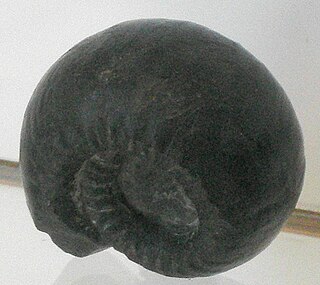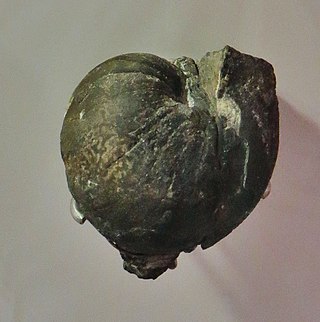
Goniatids, informally goniatites, are ammonoid cephalopods that form the order Goniatitida, derived from the more primitive Agoniatitida during the Middle Devonian some 390 million years ago. Goniatites (goniatitids) survived the Late Devonian extinction to flourish during the Carboniferous and Permian only to become extinct at the end of the Permian some 139 million years later.

Goniatites is a genus of extinct cephalopods belonging to the family Goniatitidae, included in the superfamily Goniatitaceae. Hibernicoceras and Hypergoniatites are among related genera.
Beyrichoceras is a genus belonging to the goniatitid family Muensteroceratidae, a group of ammonoids, extinct shelled cephalopods related to belemnites and recent coleoids and more distantly to the nautiloids

Gastrioceratoidea is one of 17 superfamilies in the suborder Goniatitina, ammonoid cephalopods from the Late Paleozoic.
The Ammonellipsitinae is a subfamily within the Pericyclidae, a family within the goniatitid superfamily Pericycloidea from the Lower Carboniferous (Mississippian) characterized by having a suture in which the sides of the ventral lobe diverge and the first lateral saddle is acute or subacute, and in which the immature and juvenile shell has a wide umbilicus.

Prolecanitida is an order of extinct ammonoid cephalopods, the major Late Paleozoic group of ammonoids alongside the order Goniatitida. Prolecanitids had narrow shells, discoidal (disc-shaped) to thinly lenticular (lens-shaped). They retained a retrochoanitic siphuncle, a simple form with septal necks extending backwards. As is typical for ammonoids, the siphuncle sits along the ventral margin of the shell.

Prolecanitoidea is a taxonomic superfamily of ammonoids in the order Prolecanitida. Prolecanitoidea is one of two superfamilies in the order, along with the younger and more complex Medlicottioidea. The Prolecanitoidea were a low-diversity and morphologically conservative group. They lived from the Lower Carboniferous up to the Middle Permian. Their shells are generally smooth and discoidal, with a rounded lower edge, a moderate to large umbilicus, and goniatitic to ceratitic sutures. Suture complexity varies from 10 up to 22 total lobes ; new lobes are added from subdivision of saddles adjacent to the original main umbilical lobe.
Neocycloceras is an extinct genus of nautiloid included in the Pseudorthocerida that lived during the Late Devonian and Mississippian. Neoclycloceras is characterized by a slender, generally circular shell with slightly oblique, sinuous surficial annulations. Its sutures have dorsal and ventral saddles and lateral lobes and become more oblique with age. Saddles point forward, lobes to the rear. Dorsal saddles are broad and low but the ventral ones are high and conspicuous. The siphuncle is located between the center and venter and is nummuloidal, composed of rounded expanded segments, the inside of which contains a continuous laminar lining that is thickest in the middle of the segments and thinnest at the septal necks. Neocycloceras has been found in Pennsylvania in North America and in Morocco in north Africa.
The Clydonautiloidea are a superfamily within the nautiloid order Nautilida characterized by smooth, generally globular, shells with nearly straight sutures, in early forms, but developing highly differentiated sutures in some later forms. Where known, the siphuncle tends to be central to subcentral.

The Trigonoceratoidea are a superfamily within the Nautilida that ranged from the Devonian to the Triassic, thought to have contained the source for the Nautilaceae in which Nautilus is found.

Grypoceratidae is the longest-lived family of the Trigonoceratoidea, or of the near equivalent Centroceratina; members of the Nautilida from the Upper Paleozoic and Triassic.
The Centroceratidae is the ancestral family of the Trigonoceratoidea and of the equivalent Centroceratina; extinct shelled cephalopods belonging to the order Nautilida
Aphelaeceras is an extinct genus from the nautilid family Trigonoceratidae which is part of the Trigonocerataceae, that lived during the Mississippian Period in the late Paleozoic.

Peripetoceras is a genus in the Clydonautilacean family, Liroceratidae. It can be recognized by its smooth, involute shell with a deep small umbilicus with rounded shoulders and steep convex wall; whorl section with flattened venter, rounded ventral shoulders and convergent slightly convex flanks; suture with slight ventral and lateral lobes; and small siphuncle located dorsally of the center.
Edaphoceras is a genus of koninckioceratid nautilids from the Mississippian of North America, named by Hyatt, 1884, with depressed whorls just in contact. The shell, as typical for the family, is evolute; whorl section is fusiform with broadly rounded venter and dorsum meeting at a narrow angle on either side. Its suture has a distinct ventral and dorsal lobe and an angular lateral saddle. The siphuncle is small and near central.
Neoaganides is a small, 1–2 cm diameter subdiscoidal to subglobular goniatitid belonging to the family Pseudohaloritidae that lived from the Late Pennsylvanian to the Late Permian, existing for some 56 million years.
The Uddenitinae a subfamily of the Medlicottiidae, a family of ammonoid cephalopods included in the Prolecanitida. The Uddenitinae, proposed by Miller and Furnish, and known from the Pennsylvanian and Lower Permian, are transitional between the ancestral Pronoritidae and the more traditional medlicottiids.
Neoglaphyrites is a goniatitid ammonite that lived during the latest Pennsylvanian and early Permian. Its shell is ellipsoidal and moderately involute; the umbilicus deep and typically less than 15 per cent of the shell diameter but in some species closer to 20 per cent. Delicate growth lines forming ventral and lateral sinuses and ventrolateral and dorsolateral salients have been found on Canadian Arctic specimens. The suture is characterized by the ventral lobe split into two broad prongs that are separated by a high median ventral saddle; prongs closely approximate the width of the first lateral lobe. The first lateral saddle is evenly rounded and is nearly symmetrical. The umbilical lobe is V-shaped and internal lobes are deep and narrow.
Pronorites is a prolecanitid genus from the middle and upper Carboniferous, upper Mississippian and Pennsylvanian. Distribution is wide spread.
Masonoceras is a genus of Karagondoceratids from Lower Mississippian strata, the shell of which is thinly subdiscoidal to discoidal with an acute ventral margin in late ontogeny. Whorls are strongly embracing, the umbilicus narrow to occlude. The mature external suture contains a wide trifid ventral lobe, the flanking prongs longer than the medial, an asymmetrically rounded lateral saddle and a deeper asymmetric pointed lateral lobe. Internal molds of the type, Mesoceras Kentuckiense show the presence of a broad hyponomic sinus flanked by high rounded vantrolateral salients.






